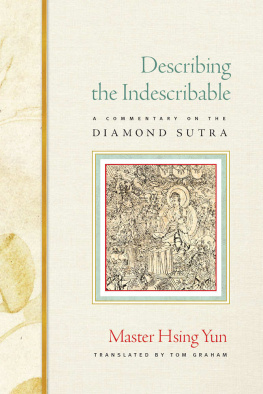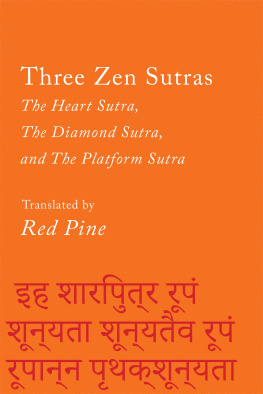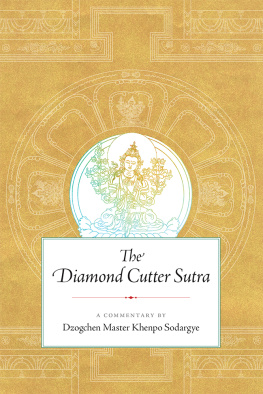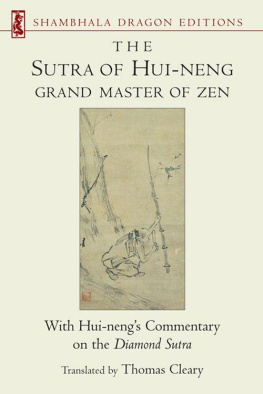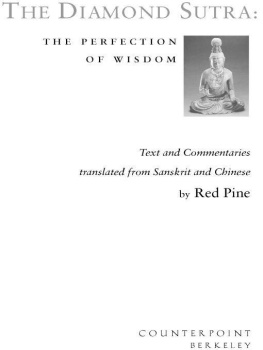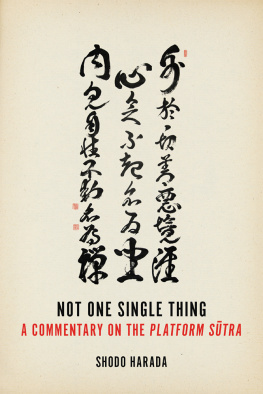
The Diamond Sutra beats with two hearts: one is wisdom and the other is compassion. To be wise is to know and understand the essence of awareness. To be compassionate is to know and understand the essence of intention. In the Diamond Sutra, the Buddha shows us that ultimately, compassion and wisdom are one.
FROM THE INTRODUCTION BY MASTER HSING YUN
The Diamond Sutra is revered as one of the Buddhas most profound expressions of the nature of reality. A gem among the vast Perfection of Wisdom literature, the Diamond Sutra elicits an experience of eternal truth through its use of a seemingly paradoxical style. Master Hsing Yun plumbs the depths of this seminal text, illuminating for us its power to change who we are and how we interpret our world.
A brilliant translation with a lucid and accessible commentary. Master Hsing Yun is truly a leading light of contemporary Chinese Buddhism.
LANCE E. NELSON, UNIVERSITY OF SAN DIEGO
Master Hsing Yun is beloved for his approachable, down-to-earth religiousness and revered for his worldly wisdom. He offers a new perspective.
BRIAN BRUYA, EASTERN MICHIGAN UNIVERSITY
M ASTER H SING Y UN is the founder of Fo Guang Shan an international Buddhist order with temples worldwide as well as the affiliated lay Buddhist service organization, Buddhas Light International. He lives in Taiwan.
T OM G RAHAM , a scholar and translator of Chinese, worked in East Asia for ten years. He lives in San Diego, California.

Contents

Translators Preface
The Buddha was a great communicator. He never hid his meaning or tried to confuse his listeners. Buddhist sutras, which are records of talks given by the Buddha, are models of clarity, insight, and intelligence. The Chinese translation of the Diamond Sutra, on which this commentary is based, is revered in East Asia largely because it possesses an uncanny clarity that almost makes us see through time to the Jeta Grove where the Buddha gave this famous talk.
Kumarajiva (344413), who made the Chinese translation in 401 C.E., must have felt a very deep sense of responsibility, for though his translation is considered to be one of Chinas great works of literature, he is said to have commented while reading it afterward that it was so uninspired it was like chewing on chips of wood. Indeed, his translation may really have sounded that way in 401 C.E. in Chang An, China. Time has a way of making great works of literature even greater because one generation after another studies them and absorbs them into the language they use. The Chinese language curls around Kumarajivas translation of the Diamond Sutra the way the English language curls around the works of Shakespeare or Chaucer. Kumarajiva established a vocabulary and a manner of expression that is echoed in almost all other Chinese Buddhist writings. As the Buddha surely would have wanted, his work is marked by its clarity, its economy of style, and its elegance.
Kumarajiva, who was of Central Asian origin, and who was as much influenced by Kashmir as he was by China, set a tone for Chinese Buddhism that has prevailed to this day. This tone, coupled with the visual beauty of the Chinese language, easily makes Buddhist literature in Chinese one of the worlds most satisfying spiritual and intellectual traditions. Master Hsing Yun is an important modern exponent of this tradition. His life and his writings have been one of the main forces in the revitalization of Chinese Buddhism in the world today. His monastery in Taiwan is the largest Chinese Buddhist monastery in the world.
Needless to say, the job of translating his work into English is not easy, especially when that work is a commentary on a sutra that was translated from the Sanskrit by Kumarajiva. Two very influential writers separated by sixteen centuries meet in a single volume, wherein one comments at length on the work of the other. Strictly speaking this is a translation that cannot be made. But Buddhism is a profound spiritual tradition based on principles deeper than the surface features of any language or even language itself. Indeed, the wisdom teachings of the Buddha, of which the Diamond Sutra is a part, state very clearly that the meaning of the Buddhas teaching must always be considered on three different levels. The first is the surface level of words, the second is the meaning of the words, and the third and most important level is the deep import of the words the oceanic depths of the Buddhas teaching that have the power to change who we are and how we interpret our worlds.
The difficulty of translating both the commentary and the sutra forced me to search for this deeper level wherever I could, and thus I sometimes had to adjust the first and second levels of meaning to fit the English language. To do this most effectively, I did not rely exclusively on Master Hsing Yuns commentary on the sutra, but consulted all of his works including oral teachings to try to forge an explication of the sutra that is true to Master Hsing Yuns deepest sensibilities as well as to the deepest meaning of the sutra. This approach has the full blessing and encouragement of Master Hsing Yun, for he understands, perhaps better than anyone, that a tentative touch, or one that is too bound up in Chinese culture, will never succeed in bringing this sutra alive for readers of English. Thus notes that once referred to idiosyncrasies of the Chinese language now may refer to idiosyncrasies of the English language, and commentary that depends on responses peculiar to a Chinese readership may now depend on responses peculiar to readers of English.
To make the commentary correspond to the sutra, I had to retranslate the sutra itself. Though several good translations of the Diamond Sutra already exist in English, they tend to be interpretive and to use vocabulary that drifts quite far from the Chinese. The translation of the sutra included in this volume is nearly literal. It is my hope that this will allow the commentary, which so often refers to the basic meanings of words, to make much better sense to readers of English. The notes section at the end of this volume is an integral part of the original commentary. These notes should serve to deepen appreciation of both the sutra and Master Hsing Yuns discussion of it.
Some people may wonder if a translation and commentary on the Diamond Sutra can be complete without including references to Sanskrit versions of the sutra. The answer to this is twofold. Firstly, Master Hsing Yuns commentary, as with most Chinese commentaries on the sutra, does not refer to a Sanskrit version. And secondly, Kumarajivas translation into Chinese is the oldest reliable version of the sutra now extant.
The Sanskrit meanings of many words are discussed in the commentary, but these discussions are based not on a Sanskrit version of this sutra, but on the ways that these words are understood within the tradition of Chinese Buddhism. These discussions are part of the first two levels of meaning that the Buddha said were necessary to get to the third and deepest level of his teachings. The effort put into understanding how the Buddha used words and why he chose the ones he did will be repaid many times, for his use of language cuts to the very core of human awareness, as it opens before us vistas that expand beyond anything we may have experienced before.
Next page
